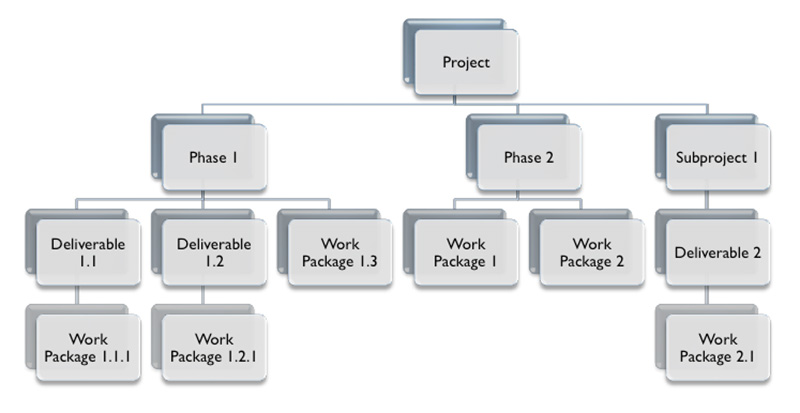 In this blog series, we'll get you up to speed on using the key tools listed in A Guide to the Project Management Body of Knowledge, (PMBOK® Guide) - Fifth Edition. First up, Work Breakdown Structure (WBS).
In this blog series, we'll get you up to speed on using the key tools listed in A Guide to the Project Management Body of Knowledge, (PMBOK® Guide) - Fifth Edition. First up, Work Breakdown Structure (WBS).
According to the Project Management Institute (PMI), the work package supposed to take between eight and 80 hours of discrete effort to complete it. The idea in setting up a work breakdown structure is that all of the effort for a project can be described with a work breakdown structure. A work breakdown structure is simply a pictorial representation of all the work needed to fulfill the goal of the project. An example is shown below:
You will notice the following about the work breakdown structure:
- It looks like an org chart, not a timeline.
- Cross functional dependencies are not shown in the chart. If cross functional dependencies between work packages were to be shown, the viewer would see a veritable rat’s nest of wires crisscrossing the page.
- For every numbered work package, there is a corresponding ‘work breakdown structure dictionary page’, i.e. a detailed description of what goes into the work package, who is doing the work, etc.
How necessary is this tool? Let’s put it this way, setting up a work breakdown structure is the equivalent of creating blueprints for a construction project. If you’ve never done this before do not worry; the newest version of Visio contains a function for creating a WBS, and Microsoft Project has an add-in called WBS Pro that easily creates a WBS. Getting up to speed on this tool is just a question of practice: the more you practice the better you’ll be.
This is an excerpt from the Global Knowledge white paper, Are All Those Project Management Tools Really Needed?
ABOUT THE AUTHOR
Richard J Perrin has worked in the aerospace, finance/brokerage, healthcare, energy, telecommunications, and insurance industries as well as state and federal government for over 30 years. Working primarily for Fortune 100 and Global 10 companies as a program/project manager, he has managed multi-million dollar, international infrastructure deployments, consulted in the creation of PMOs, functioned as proposal manager, developed workflows and business process focusing on the implementation of lean business process and quality practices for the publishing and telecom industries, as well as the public sector. For the last four years he has devoted his efforts to delivering coaching and training on Agile/Scrum processes across the United States. His book, Real World Project Management was published by John Wiley & Sons and released in January 2008. Most recently, he was selected by the Project Management Institute as an internal reviewer/contributor for A Guide to the Project Management Body of Knowledge (PMBOK® Guide)—Fifth Edition.
Related Courses
PMP® Exam Prep Boot Camp


 Worldwide Locations
Worldwide Locations
